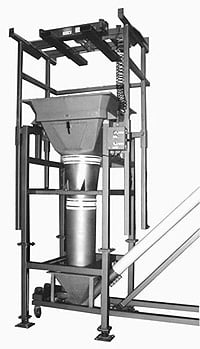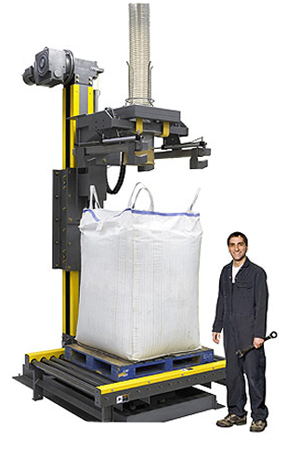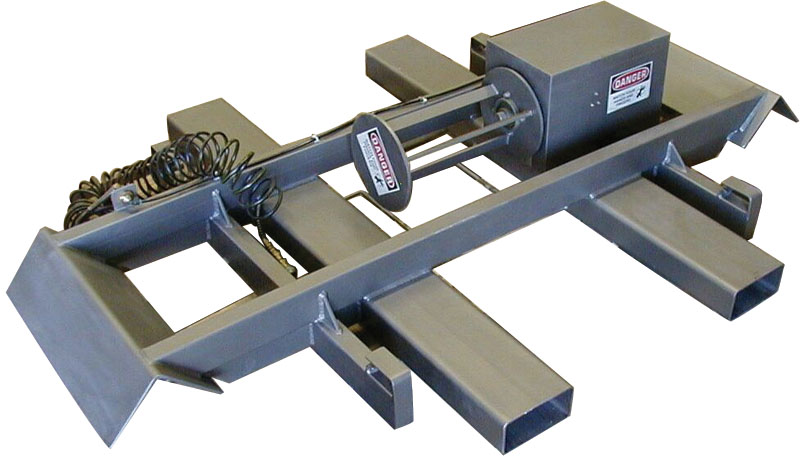Topics: bulk bag conditioner, bulk bag, bulk bag condition, Bulk Bag Conditioners, bulk handling equipment, Bulk Material Handling, bulk solids conveying, conditioner
Topics: bulk bag filler, bulk bag, bulk bag fillers, bulk bag handling equipment, bulk bagging equipment, Bulk Material Handling, bulk material handling equipment, filler, bulk bag filling equipment, cte filler
How much product are you giving away for free in you bulk bags?
Topics: bulk bag filler, bulk bag, bulk bags, bulk bag filling, bulk bag fillers, Bulk Material Handling, dry bulk material handling, dry bulk solid, overfilling bags, profit, profitability bulk bag filling, profitability bulk bags, overfilling, overfilling bulk bags
Bulk Bag Conditioners are Vital Addition to Bulk Bag Discharging Process
Topics: bulk bag conditioner, bulk bag, bulk bag conditioning, Bulk Bag Conditioners, bulk bag conditioning system, compacted material, conditioner, dry bulk solids
The Importance of Accurate Weighing When Filling Bulk Bags
Topics: bulk bag, batch weighing, batch weighing system, bulk bag fillers, Bulk Material Handling, weigh batching, gain-in-weight, loss-in-weight
Read on to learn how to fill lined bulk bags.
Typically, bulk bag liners are made from polyethylene film and are, in effect, ‘inner bags’ that are placed within a bulk bag or FIBC. The product contacts the liner not the bulk bag.
There are generally two types of liners: loose and form fit.
- Loose liners: a cylinder of PE film that is stuffed into the bag. Loose liners are occasionally glued to the bulk bag.
- Form fit liners: a PE film ‘container’ that looks just like a bulk bag (four sides, top and bottom, inlet and outlet spouts) that is placed within the bulk bag. Often, form fit liners are attached to the bulk bag by various methods including tabs that are sewn into the top (and sometimes bottom) seams of the bag.
Filling Bulk Bags with Loose Liners
The most critical factor in filling a bulk bag with a loose liner is to ensure that the liner has expanded and ‘taken’ the cubic shape of the bulk bag before it is filled. Otherwise, there is a high probability that the unexpanded loose liner will have folds in it that the product will fill over thereby making it extremely difficult (if not impossible) to discharge.
over thereby making it extremely difficult (if not impossible) to discharge.
Blowing air into the liner, generally referred to as inflation, is the quickest and easiest method to expand a loose liner. A fan blower can be used or a device called an eductor connected to a source of compressed air that draws in ambient air are the two most common inflation methods.
The other consideration when filling loose liners is to allow the inlet of the liner to slide down as the bag is being filled while still maintaining a secure grip. If the liner inlet is held so that it cannot move it is highly likely the top corners of the bag will not be filled because the liner will form a peak extending from the fill head where it is clamped to somewhere down the sides of the bag. In this case it would be impossible to fill the bag to target weight unless the bag is significantly oversized.
Filling Bulk Bags With Form Fit Liners
If your bulk bag filler is designed so that the bulk bag rests on a pallet or other flat surface throughout the filling cycle even bags with form fit liners that are attached to the outer bulk bag should be inflated. Otherwise, as with loose liners, the bag may be folded or creased in such a way that the product will fill over the folds or creases thereby impeding discharge and the ability to completely fill the bulk bag.
However, if your bulk bag filler features ‘hang filling’ where the bulk bag spends part of the filling cycle hanging suspended from its loops, inflating form fit liners is unnecessary.
Topics: big bags, bulk bag liner, form fit liner, bulk bag, loose liner
Bulk Bag Batching: Improve Weighing Accuracy
 Recently, we engaged with a customer that a few years ago had spent over $2 million with another vendor on an 18 station, automated bulk bag batching system. Depending on the recipe some or all of the 18 different ingredients are simultaneously metered onto a common belt conveyor for transfer to one of two mixers. Each station dispenses its ingredient in specific batch weights according to the recipe.
Recently, we engaged with a customer that a few years ago had spent over $2 million with another vendor on an 18 station, automated bulk bag batching system. Depending on the recipe some or all of the 18 different ingredients are simultaneously metered onto a common belt conveyor for transfer to one of two mixers. Each station dispenses its ingredient in specific batch weights according to the recipe.
Unfortunately, the system doesn't work.
Individual ingredient batch weights are inaccurate and vary both above and below the weight setpoint and the variations are random. Therefore, the total recipe weights are inconsistent and are randomly under or over weight.
As a result, they have had to go back to adding most of the ingrdients by hand and use the automated system for only four or five ingredients.
The customer asked Control and Metering if we had any ideas that might help them. Based on a very brief overview of the system and how it operates we identified two key factors that we believe may be root causes of the weighing problem. These factors are critical to achieving success with any batching system.
- Dry bulk solid metering device selection. The 18 ingredients vary dramatically in their bulk density, particle size distribution and flow characteristics. Each station must be optimized for its ingredient so that the bulk bag discharger maintains a steady flood feed condition to the metering device and so that the metering device is properly selected to maintain a constant - and therefore accurate - feed rate when it is dispensing its batch. In this case, vibratory feeders were supplied at every station, which appear to be inneffective with many of the ingredients.
- Batch weighing structure integrity. Each of the 18 bulk bag batching stations are constructed of 3" steel tubing and the metering devices - vibratory feeders - are suspended below each frame on chains. Load cells are located under each of the bulk bag discharger legs. We suspect that the overal structure lacks integrity and may well exhibit hysteresis - the frame subtly shifts each batch run or series of batch runs and the weighing system physically alters its orientation - perhaps by only millimeters - between batches. Further, it may be that frame flexing occurs during batch operation. Both of these phenomenon, if they are occuring, would lead to random batch inaccuracies. The weigh frame or weighed structure must be designed to avoid frame flexing and deformation so that the weighing system remains structurally rigid from batch to batch.
Learn more about bulk bag batching systems.
Topics: bulk bag, vibratory feeder, bulk bag batching, batching system, bulk bag batching system
Sizing Bulk Bags: Filling Technology Can Save Money
 As was pointed out in an earlier blog post "How Big is A Bulk Bag", there is no such thing as a 'standard' sized bulk bag. The base or bottom seam dimensions are generally sized to fit within the mode of shipping to be used (shipping container, truck trailer, etc.) and/or to fit properly on the selected pallet.
As was pointed out in an earlier blog post "How Big is A Bulk Bag", there is no such thing as a 'standard' sized bulk bag. The base or bottom seam dimensions are generally sized to fit within the mode of shipping to be used (shipping container, truck trailer, etc.) and/or to fit properly on the selected pallet.
Depending on the bulk density of the product and its characteristics, the bulk bag's height can be significantly affected by the bulk bag filling technology employed. And, this can be a source of lucrative operating cost savings!
If your product's packed bulk density is around 35 lb/cu ft or less and its loose bulk density is more than 10-15% less than that, chances are reasonable that you are not able to achieve bulk bag weights of 2,000 to 2,205 lb using bulk bags sized to fit within a shipping container or a truck trailer.
If that's the case, maximum densification during filling can in most cases put more weight into the same sized bulk bag.
When that happens operating cost savings pile up quickly:
- Since you can put more weight in each bag, you can buy fewer bags. A 10% increase in payload weight equals a 10% reduction in the number of bags you have to buy!
- Since you can put more weight in a container or trailer there are fewer shipments that must be made and each shipment carries more weight per container. Once again, a 10% increase in payload weight reduces the number of containers thereby reducing shipping costs. This can be a HUGE cost savings!
So, if you are unable to currently achieve one ton/tonne payload weights in your bulk bags investigate using bulk bag filling technology that will mazimize densification. You may be able to put tens and even hundreds of thousands of dollars onto your plant's profit line by increasing the payload weight of your current sized bulk bags !
Topics: bulk bag filler, bulk bag dimensions, bulk bag, bulk bag size, bulk bag filling
Loose Bulk Bag Liners and Dry Bulk Ingredient Flow Problems
 Do you receive ingredient in bulk bags with loose liners? Do you have problems getting the ingredient to flow from the bulk bag? Here's some tips on how to overcome bulk bag discharging flow problems.
Do you receive ingredient in bulk bags with loose liners? Do you have problems getting the ingredient to flow from the bulk bag? Here's some tips on how to overcome bulk bag discharging flow problems.
Focus on how the bags are filled.
Flow problems often are the result of the bulk bag liner not being inflated prior to filling. If this crucial step is not taken, the liner can fold over itself in the bottom of the bag. If that happens and a ton of ingredient is filled into the bag on top of the folds, flow problems are sure to occur.
The only way to prevent this is to properly inflate the liner just prior to filling so that it takes the shape of the bulk bag without folding over on itself. Talk to your supplier or, if you fill bulk bags for in-house or intra-company use, take a close look at your bulk bag filling equipment and standard operating procedures.Optmize liner handling during discharge.
Liner tensioners are devices that wind up loose liners during discharge to prevent them from 'growing' too far out of the bottom of the bulk bag and becoming entangled in downstream equipment. They also improve product flow and ensure that all of the ingredient is discharged from the liner thereby providing 100% yield.
Using one of a number of different styles of liner tensioner can prevent flow problems from bulk bags with loose liners.
- Hold in place. The simplest type of liner tensioner simply holds the liner in place to prevent it from completely exiting the bottom of the bag during discharge. Make sure that there is sufficient space between the bottom of the bag and the downstream equipment so that when the liner grows out of the bag during dicsharger it doesn't become entangled in downstream equipment. Also note that this style tensioner does not pull up on the liner and therefore does not do an effective job of ensuring complete discharge.
- Partial wind up. A pneumatically actuated tensioner winds up a predetermined amount of the liner during discharge - say 24" - 36". This reduces or eliminates liner growth out of the bag bottom and ensures complete discharge.
- Complete wind up (see photo above). If you use a discharger that clamps the liner outlet you must use a tensioner that continuously winds the liner. Otherwise, the liner will gather at the clamp and almost always prohibit ingredient flow. This type of discharger and tensioner are typically used when dust containment is critical.
Topics: bulk bag, bulk bag discharging, loose bulk bag liners, bulk bag discharger, bulk bag liners
 There are a number of factors involved in successfully stacking bulk bags. The one most overlooked is that your filled bulk bags must have a flat top!
There are a number of factors involved in successfully stacking bulk bags. The one most overlooked is that your filled bulk bags must have a flat top!
Most dry bulk solids have an angle of repose. If you pored a handfull of your product on a flat surface it would form a peak. The angle of the peak with the horizontal varies depending on the properties of the product.
When product is poured into a bulk bag it forms a peak just the same as the example above. However, if you plan to stack bulk bags it is critical that your bulk bag filling equipment densifies the product enough to produce a flat top.
A filled bulk bag with a flat top provides a stable platform on which to stack. Without it, the odds of a leaning or falling stack are greatly increased.
If you are stacking bulk bags or plan to, safety is the first priority. Make certain that your bulk bag filling equipment can produce a flat topped bag before you do anything else!
See how Control and Metering's cone table densifiction technology produces flat topped bulk bags!
Topics: bulk bag filler, bulk bag densification, bulk bag, cone table, bulk bag filling


